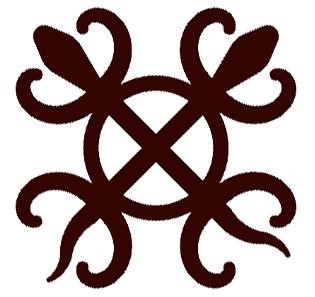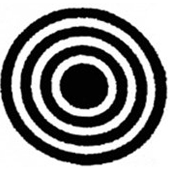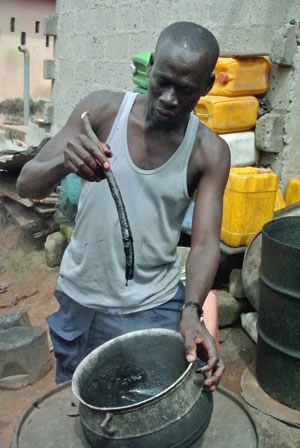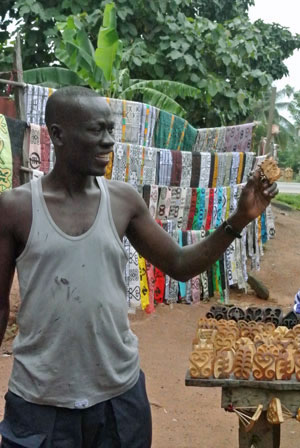Adinkra Cloth


Adinkra are symbols from the West African nation of Ghana. Each symbol holds a meaning that represents important aspects of their knowledge system. In the “twin crocodile” symbol, Funtunfunefu-Denkyemfunefu, both animals share a single stomach. This symbol represents the concept that fighting among ourselves for resources is pointless: “by feeding you, I feed myself.” Cloth stamped with Adinkra symbols can tell a story about which concepts are most important to you. It is worn during special occasions or ceremonies.
Where Did Adinkra Geometric Forms Come From?
Like all cultures, the Ashanti developed their math ideas from both natural and social influences. Below you can see 3 stages:
- Observing an object from nature or culture.
- Artistically representing this object.
- Abstracting the art into geometric forms. This makes the stamps easier to reproduce, and the symbols easier to recognize. And it helps us see why African mathematical traditions were slightly different from those of Europe: there is more emphasis on iteration and logarithmic curves.
From Nature
Original Object

Water Drop
Artistic Representation

Soul Washer"s Badge
Adinkra Symbol

Adinkrahene Symbol
Description
Photos of water ripples are often used to study fluid physics. Ghanaian artisans were also keen observers of fluid shapes. We can identify a ripple pattern in the gold "Soul Washer"s" badge - worn by the Ghana priests who conducted the king"s water rituals. This suggests an origin for the adinkrahene ("king of adinkra") symbol: ripples of power spread in all directions.
Making Adinkra Cloth

Gabriel Boakye, Adinkra Artisan
Adinkra cloth is one of the traditional cloths of the Asante people. It is produced by stamping or printing Adinkra symbols onto cloth. Adinkra artisans use a traditional process to design the cloth, carving their own stamps, making their own ink, and stamping the fabric.
Making Ink


Shaving the Bark

Pounding the Bark

Boiled Ink
The ink for Adinkra stamping is made from the bark of the Badie tree (Bridelia ferrungia). First, the outside bark is cut away, leaving a red fiber. Next, the red fiber is soaked in water for about 24 hours to make it soft. The soaking makes the water lightly colored; at this point it is called 'adinkra aduru' ("adinkra medicine"). It is traditionally used to treat gastric illness such as dysentery. Scientists have confirmed that it has antimicrobial and anti-inflammatory activity.
The red fiber is then pounded to make it even softer and placed back in the water to be boiled for two days. After cooking for two days, the bark is strained out of the water, and can be used to grow mushrooms. In traditional culture little is wasted: what comes from nature is returned to nature.
With the bark removed, the liquid is boiled a final time, reducing it in volume. This final boiling produces a thick black ink for stamping.
Carving Stamps
Adinkra symbols are carved into the calabash gourd. Calabash is similar to squash or pumpkin. Below is a picture of Paul Boakye, a master Adinkra artisan, cutting off pieces of a calabash to make a stamp for the Adinkra symbol, Mmusuyidee, which means to “remove bad luck.”

Paul Boakye is Carving Stamps from a Calabash

Three Adinkra Stamps

Gabriel Boakye's Display of Many Adinkra Stamps

Bamboo Sticks Attached as Grip
Stamping the Adinkra Cloth
When the Adinkra artisan is ready to stamp the fabric, a strip is laid out across a long table. The stamps are then dipped in ink and pressed down on the cloth in a pattern. The placement of symbols has meaning and tells a story to others.

For more information on Adinkra, click here!